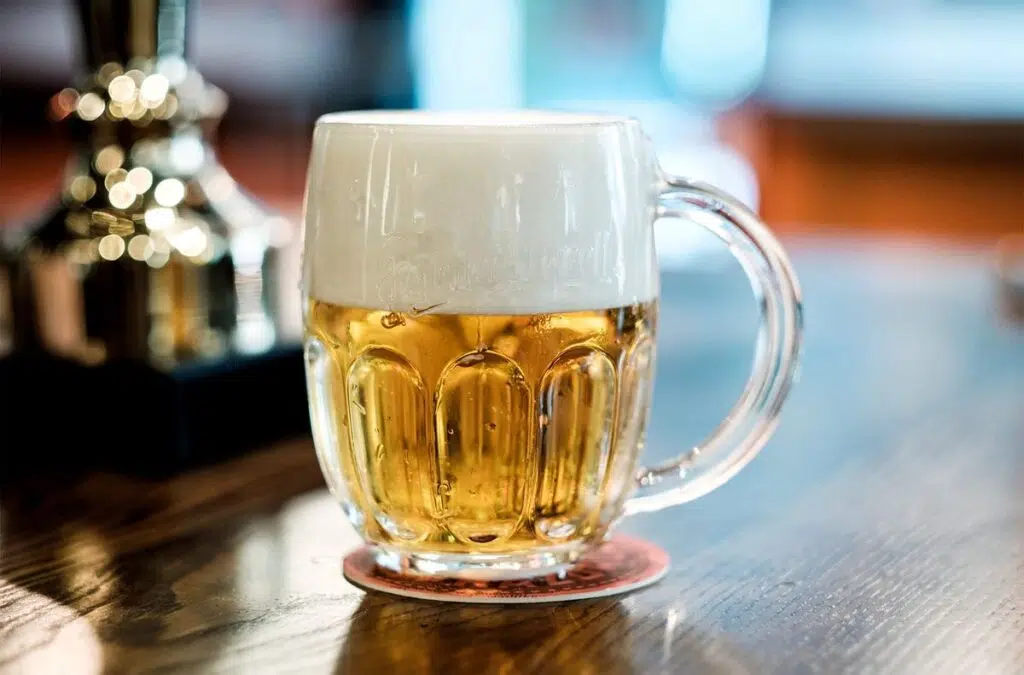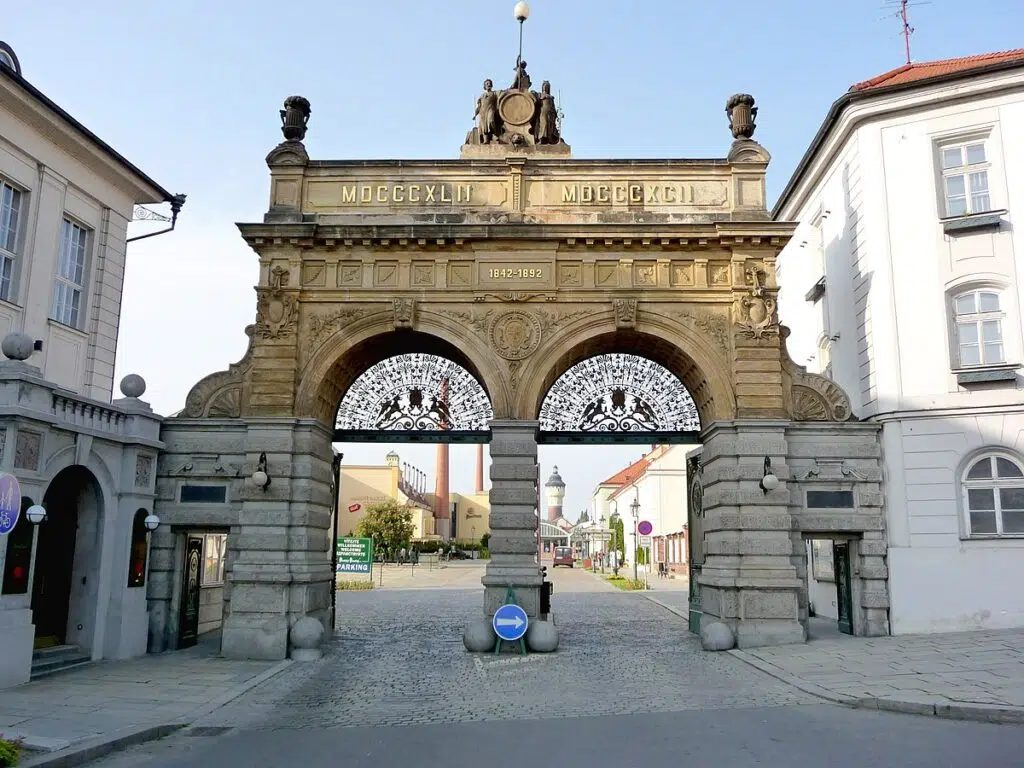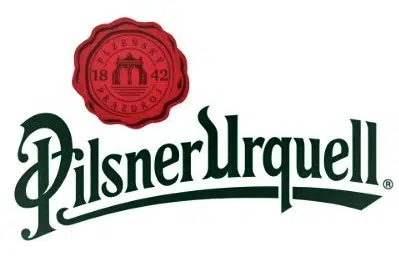
What is a Pilsner-Style Lager Beer?
A Pilsner Beer is a golden-colored lager-style beer brewed with a specific blend of Moravian barley, Žatec hops, and a unique strain of Bavarian yeast.
Where does Pilsner-Style Lager beer come from?
Pilsner Beer is named for the city of Pilsen (Plzeň) in the Czech Republic. It is a Lager beer with a history of only a 200-year-old history involving one of the world’s most famous breweries, Pilsner Urquell.
When the city was founded in 1295, King Wenceslas II gave burghers his permission to brew beer, and they were able to sell beer in their homes. Town magistrates checked the beer quality by pouring a pitcher of beer on oak benches. Then they would sit down. They stood up one hour later. The beer was considered undrinkable if their leather pants did not stick to the bench. In 1838, 36 barrels of sour beer were spilled out in front of the town hall, an event that triggered beermakers to set up the Burghers’ Brewery
What makes Pilsner-Style Lager Beer unique?

According to the official site of the Pilsner Urquell brewery…
“In 1842, at our brewery in Plzeň, brewer Josef Groll introduced the world to the first golden ‘pilsner’ lager and changed beer forever. His invention soon became the most popular beer style on the planet.”
The yeast used to ferment (Lager) this beer and the use of Žatec hops to get its unique flavor and aroma. This was essential to the development of the Pilsen style of beer. Its characteristic aroma of malt grains and balanced caramel taste is achieved through triple mashing, the soft Pilsen water, and the Žatec hops added for a smooth bitterness. The malt itself gives the beer its distinctive golden color.
The History of Pilsner Urquell

The inspiration for the Pilsner-Style Lager originated in 1838 after tavern owners in Pilsen (Plzeň in Czech) poured 36 barrels of the local beer down the drains and sparked a revolution in brewing.
They had heard of the new method of brewing being done in neighboring Munich using newly invented ice-making machines to “Lager” their beer.
First, it was the Burghers’ Brewery
Local brewers and tavern owners began raising funds to build a new brewery called Burghers’ (Citizens’) Brewery. Martin Stelzer, a leading architect of the time, was hired to design the brewery.
First, he toured Europe and Britain to study modern breweries that used the new technologies, steam power, and artificial refrigeration—to make beer.
Stelzer returned to Pilsen and started construction on a site in the Bubenc district. It had a plentiful supply of soft water and sandstone foundations where deep cellars could be dug to store or “lager” beer.
He also commissioned a Bavaria brewer called Josef Groll, who knew how to brew lager beer with the new cold-fermented brewing style. The first batch of beer was introduced on November 11, 1842.
It was an immediate success. First of all, it was a golden beer, the first truly pale beer ever seen in central Europe. Legend has it that the golden color was because the wrong type of malt was delivered to the brewery by mistake. It’s more likely that Stelzer brought an English malt kiln fired by coke rather than wood. This type of kiln was used to make pale malt, the basis of the new style of beer brewed in England called Pale Ale.
Groll used high-quality Moravian barley, low in the nitrates that cause hazes. The incredibly soft water of Pilsen and the spicy Saaz hops from the Žatec region combined to make this beer unique.
When did today’s Pilsner Urquell Brewery go into operation?

It wasn’t until the communist era after World War II that the brewery’s name was officially changed to Pilsner Urquell.
Since 2005, the brewery has been owned by the SABMiller international group.
What The Professionals Have to Say About Pilsner-Style Beer:

Beer Judge Certification Program
This style is a light-straw-colored, full-bodied, lagered, bottom-fermented beer named after the town of Pilsen (in what was then known as Bohemia), where it was first brewed in 1842. It quickly became a popular unique style because it was so different from the amber brews that were the norm.
The Beer Judge Certification Program lists the aroma, appearance, flavor, mouthfeel, and vital statistics as parameters for three “styles” of Pilsner beer.
Go to Beer Judge Certification Program for the following and more information.
2A. German Pilsner (Pils)
“Aroma: Typically features a light grainy malt character (sometimes Graham cracker-like) and distinctive flowery or spicy noble hops….”
“Appearance: Straw to light gold, brilliant to apparent, with a creamy, long-lasting white head.”
“Flavor: Crisp and bitter, with a dry to medium-dry finish. Though some grainy flavors and slight malt sweetness are acceptable, moderate to moderately low yet well-attenuated maltiness. Hop bitterness dominates the taste, continues through the finish, and lingers into the aftertaste. Hop flavor can range from low to high but should only be derived from German noble hops. Clean, no fruity esters, no Diacetyl.”
“Mouthfeel Medium-light body, medium to high carbonation.”
Overall Impression: Crisp, clean, refreshing beer that prominently features noble German hop bitterness accentuated by sulfates in the water.
Ingredients: Pilsner malt, German hop varieties (especially noble varieties such as Hallertauer, Tettnanger, and Spalt for taste and aroma), medium sulfate water, German lager yeast.
2B. Bohemian Pilsener
“Aroma: Rich with complex malt and a spicy, floral Saaz hop bouquet. Some Diacetyl is acceptable but need not be present. Otherwise clean, with no fruity esters.”
“Appearance: Very pale gold to deep burnished gold, brilliant to very clear, with a dense, long-lasting, creamy white head.”
“Flavor: Rich, complex maltiness combined with Saaz hops’ pronounced yet soft and rounded bitterness and flavor. Some Diacetyl is acceptable but need not be present. Bitterness is prominent but never harsh and does not linger. The aftertaste is balanced between malt and hops.”
“Mouthfeel: Medium-bodied (although Diacetyl, if present, may make it seem medium-full), medium carbonation.
“Comments: Uses Moravian malted barley and a decoction mash for rich, malt character. Saaz hops and low sulfate, low carbonate water provide a distinctively soft, rounded hop profile… Dextrins provide additional body, and Diacetyl enhances the perception of a fuller palate.”
“Ingredients: Soft water with low mineral content, Saaz hops, Moravian malted barley, Czech lager yeast.”
2C. Classic American Pilsner
“Aroma: Low to medium grainy, corn-like, or sweet maltiness may be evident (although rice-based beers are more neutral). Medium to moderately high hop aroma, often classic noble hops….”
“Appearance: Yellow to deep gold color. Substantial, long-lasting white head. Bright clarity.”
“Flavor: Moderate to moderately high maltiness similar to the Continental Pilsners but somewhat lighter in intensity due to up to 30% flaked maize (corn) or rice used as an adjunct. The slight grainy, corn-like sweetness from the use of maize with substantial offsetting hop bitterness. Rice-based versions are crisper, drier, and often lack corn-like flavors. Medium to strong hop flavor from noble hops (late addition or first-wort hopped)….”
“Mouth Feel: Medium body and rich, creamy mouth feel. Medium to high carbonation levels.”
“Overall Impression: A substantial Pilsner that can stand up to the classic European Pilsners, exhibiting the native American grains and hops available to German brewers who initially brewed it in the USA. Refreshing, but with the underlying malt and hops that stand out compared to other modern American light lagers. Maize lends a distinctive grainy sweetness. Rice contributes a crisper, more neutral character.”
“Ingredients: Six-row barley with 20% to 30% flaked maize to dilute the excessive protein levels. Native American hops such as Clusters, traditional continental noble hops, or modern noble crosses (Ultra, Liberty, Crystal) are also appropriate. Modern American hops such as Cascade are inappropriate. Water with a high mineral content can lead to an inappropriate coarseness in flavor and harshness in the aftertaste.”
Tasting Notes From:
SOURCES:
A Short History of Pilsner Urquell
https://www.czechcenter.org/blog/2021/6/28/a-short-history-of-pilsner-urquell
Archives at Pilsner Urquell. Protz, Roger. The taste of beer. London: Weidenfeld & Nicolson, 1988.
Wikipedia – Pilsner Urquell
